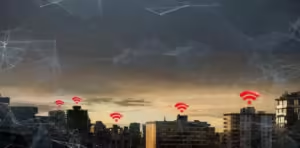Introduction
In an era where digital connectivity is ubiquitous, the demand for wireless communication continues to soar. However, this increasing reliance on wireless networks comes with a significant environmental cost. Traditional wireless infrastructure consumes vast amounts of energy and often relies on non-renewable resources, contributing to carbon emissions and environmental degradation. To address these challenges, the concept of Green Wireless Networks has emerged as a promising solution, aiming to make wireless communication more energy-efficient and sustainable.
Importance of Energy-Efficient Communication
Energy efficiency in wireless communication is crucial for several reasons. Firstly, it reduces the environmental impact of network operations, helping to mitigate climate change and preserve natural resources.
Secondly, energy-efficient networks can lower operational costs for service providers, leading to more affordable services for consumers. Additionally, by optimizing energy usage, green wireless networks can extend the lifespan of battery-powered devices, enhancing user experience and reducing electronic waste.
Challenges in Current Wireless Networks
Despite their widespread adoption, traditional wireless networks face numerous challenges related to energy consumption and environmental sustainability. The proliferation of mobile devices, the growing demand for data-intensive applications, and the expansion of network coverage exacerbate these challenges. Moreover, the reliance on fossil fuels for powering network infrastructure poses long-term risks to both the environment and energy security.
Key Components of Green Wireless Networks
To transition towards more sustainable wireless communication, green networks incorporate several key components:
- Energy-Efficient Hardware: Utilizing hardware components to minimize power consumption without compromising performance.
- Sustainable Power Sources: Integrating renewable energy sources such as solar, wind, and kinetic energy to power base stations and other network infrastructure.
- Intelligent Network Management: Implementing advanced algorithms and protocols for optimizing energy usage, scheduling transmissions, and managing network resources efficiently.
Strategies for Energy Conservation in Wireless Communication
Green wireless networks employ various strategies to conserve energy, including:
- Dynamic Power Management: Adapting transmit power levels based on signal strength, network congestion, and user activity to minimize energy consumption.
- Sleep Mode Optimization: Putting idle network components into low-power sleep modes when not in use reduces energy waste.
- Resource Allocation Techniques: Allocating network resources dynamically based on demand, traffic patterns, and Quality of Service (QoS) requirements to maximize energy efficiency.
Renewable Energy Integration in Wireless Networks
The integration of renewable energy sources plays a pivotal role in making wireless networks more sustainable:
- Solar-Powered Base Stations: Deploying solar panels to harness sunlight and convert it into electricity to power base stations and other network infrastructure.
- Wind-Powered Infrastructure: Utilizing wind turbines to generate electricity for remote or off-grid locations, reducing reliance on conventional power sources.
- Energy Harvesting Technologies: Leveraging ambient energy sources such as radio frequency (RF) signals, vibrations, and thermal gradients to supplement power requirements and extend battery life in wireless devices.
Optimization Algorithms for Green Wireless Networks
Advanced optimization algorithms are instrumental in achieving energy efficiency in wireless communication:
- Machine Learning Approaches: Using machine learning algorithms to analyze network data, predict traffic patterns, and optimize energy usage in real time.
- Heuristic Optimization Techniques: Employing heuristic algorithms to solve complex optimization problems, such as resource allocation and power control, with near-optimal solutions.
- Game Theory Applications: Applying game theory principles to model interactions between network entities and devise strategies for energy-efficient communication and resource allocation.
Environmental Impact Assessment of Green Wireless Networks
The adoption of green wireless networks yields several environmental benefits:
- Reduction in Carbon Footprint: By minimizing energy consumption and transitioning to renewable energy sources, green networks help reduce greenhouse gas emissions and combat climate change.
- Mitigation of Electronic Waste: Prolonging the lifespan of battery-powered devices and promoting sustainable practices in network deployment and operation reduces electronic waste generation.
- Sustainable Development Goals Alignment: Green wireless networks contribute to achieving various Sustainable Development Goals (SDGs), including affordable and clean energy, climate action, and sustainable cities and communities.
Case Studies and Success Stories
Numerous case studies demonstrate the effectiveness and viability of green wireless networks:
- Implementation in Urban Settings: Cities worldwide are deploying energy-efficient wireless networks to enhance connectivity while reducing environmental impact and operating costs.
- Rural Connectivity Solutions: Green wireless technologies are bridging the digital divide by providing cost-effective and sustainable connectivity solutions in rural and remote areas.
- Community-Based Initiatives: Grassroots initiatives and community-driven projects leverage green wireless networks to address local communication needs while promoting sustainability and resilience.
Future Directions and Emerging Trends
The future of green wireless networks is characterized by ongoing innovation and technological advancements:
- 6G and Beyond: Next-generation wireless technologies, such as 6G, will prioritize ultra-efficient communication, leveraging advanced techniques for energy harvesting, spectrum optimization, and network virtualization.
- Integration with the Internet of Things (IoT): The proliferation of IoT devices necessitates energy-efficient communication protocols and network architectures to support massive connectivity and diverse applications.
- Policy Implications and Regulatory Frameworks: Governments and regulatory bodies play a crucial role in fostering the adoption of green wireless networks through supportive policies, incentives for renewable energy deployment, and environmental standards for network operators.
Conclusion
Green wireless networks represent a paradigm shift towards more sustainable and environmentally responsible communication infrastructure. By embracing energy efficiency, renewable energy integration, and advanced optimization techniques, these networks offer a pathway to a greener, more connected future. As we continue to innovate and collaborate, the vision of sustainable wireless communication can be realized, benefitting both society and the planet.












